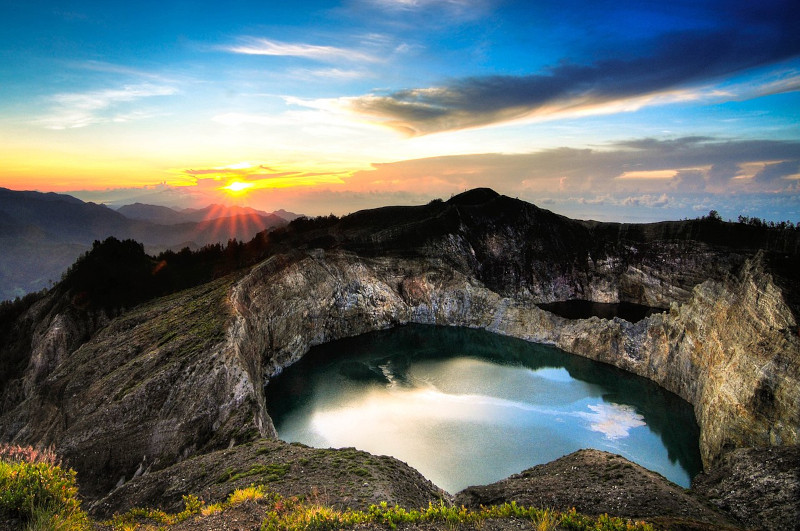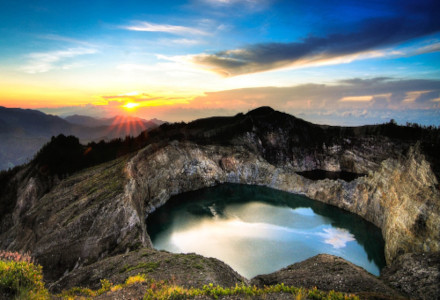
Photographer: Bagus Pinandoyo Basuki
CCL: https://bit.ly/2SOHb8z
Kelimutu Facts
- The incredible marvel of nature known simply as Kelimutu stands out from others of its kind as a truly remarkable volcano. Furthermore, this impressive geological feature earns that unique distinction for a truly remarkable reason. That’s because this marvel of geology represents one of the few known volcanoes to actually possess a total of 3 calderas.
- However, the simple fact that it possesses such an almost unheard of number of calderas isn’t the only reason for its fame. In point of fact, the magnificent site holds yet another startling secret. That’s because each of these separate depressions also contains a lake. But the wonders don’t end there. Each of these surprising lakes also contains different colored water.
- In addition, the lakes of Kelimutu only partially attain their colors as a result of the activities of the volcano. The volcanic gases emitted by fumaroles in the crater of Kelimutu also interact with chemicals in the water of each lake. The colors of the bodies of water actually change from time to time as a result of random periodic alterations in their chemical composition.
Related Articles
Kawah Ijen Stromboli Mount Bromo
Photographer: Ignas Kunda
CC License: https://bit.ly/3xkg9on
Kelimutu Physical Description
The mesmerizing beauty of Kelimutu isn’t its only respectable statistic. It also has some other characteristic worth admiring. For one, it also resides at an altitude of roughly 5,377 ft (1,639 m) above sea level. In addition, two of the calderas actually have a shared wall, while the third sits a short distance to the west. The walls of each one vary in height, with the highest prominence being 157 ft (48 m).
The lone lake to the west typically displays blue water. Meanwhile, the other two calderas of the astounding volcano, that share a wall, typically display green and red water. In addition, these gorgeous colors also change periodically. Somewhat surprisingly, these hues sometimes include brown and black. Finally, geologists consider Kelimutu inactive since the last eruption was in 1968.
Photo Credit: simontour.info
CC License: https://bit.ly/2UpDypO
Kelimutu Location and Nature
The stunning masterpiece created by the forces of Nature that mankind calls Kelimutu lies in a somewhat remote portion of the world. More precisely, the marvelous volcano sits on an island bearing the name of Flores. This location lies in the section of the earth known as Indonesia, in Asia.
In addition, the summit of this volcano has become highly elongated over time. This formative action occurred as a direct result of geological forces. Due to their slow but irresistible efforts, the site now has a roughly rectangular shape. Furthermore, many small fumaroles also populate the floors of the calderas.
The powerful gases released by these fumaroles also have a direct bearing on the coloring of the waters. That’s because these strongly interact with the various chemicals and minerals inherent to the individual lakes. The resulting colors, therefore, due to wholly random combinations, present differently as well.
Finally, the staggering site of Kelimutu sits alone in its area. In fact, even today, the nearest populated area remains the town named Moni, by the locals. This residential area sits approximately 50 mi (80 km) away from the volcano. Despite its remoteness, however, it has become a popular tourist attraction.
Features Sharing Its Region
Kuang Si Falls Er Wang Dong Wadi Rum
Check out our other articles on Pingualuit Crater Lake, Homestead Caldera, Fly Geyser, Lagoa do Fogo, Boiling Lake, 7 Spellbinding African Marvels

